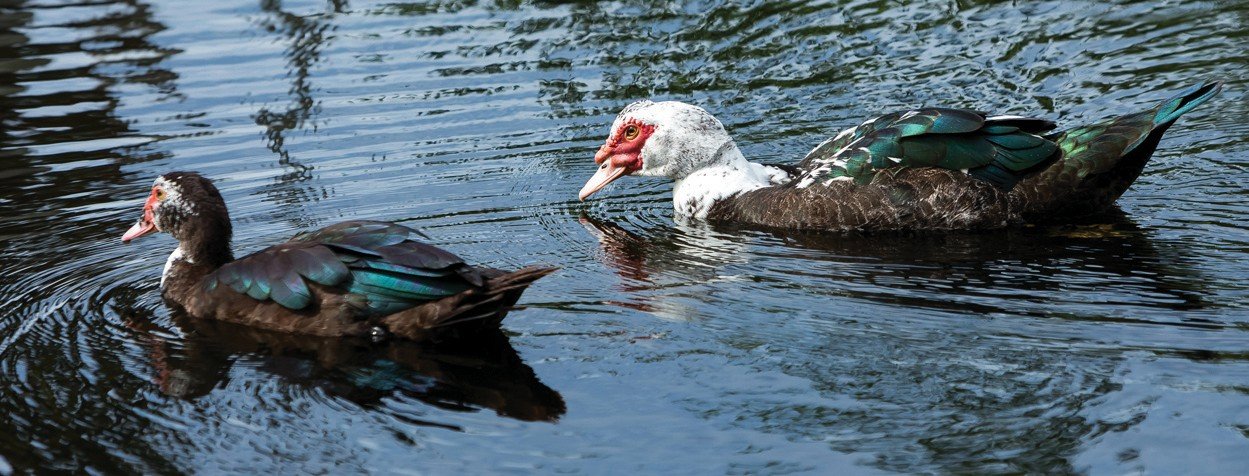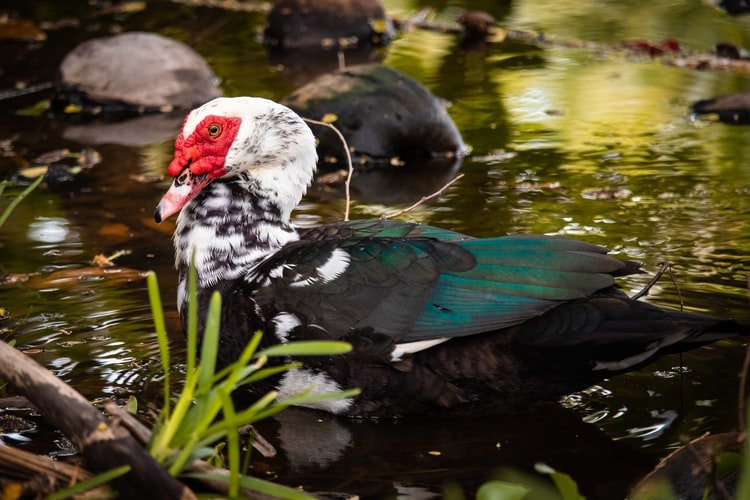Muscovy Duck: Cairina Moschata

Although we refer to the muscovy as a duck, it is not one. The muscovy is a South American waterfowl with a duck-like body, a goose-like behavior in which it hisses rather than quacks, a turkey-like breast, and chicken-like roosters.
Muscovy ducks have a 35-day incubation period, whereas ducks have a 28-day incubation period. Muscovies will breed with domestic ducks, but the offspring are infertile and are referred to as ‘mule’ ducks. Those ducks are born sterile. 1Go To Source afs.ca.uky.edu -“Duck”
Learn More: Harmful Birds
Description Of The Muscovy Duck
Muscovy Ducks have large, heavy bodies and long necks, giving them the appearance of small geese. They have a long bill that gently slopes up to the top of the head. The tail is a good length. Males are typically larger than females, and domesticated Muscovy is frequently larger than their wild counterparts.
Muscovy Ducks in the wild are mostly black. The adult males’ wings have large white patches, whereas the juveniles’ white wing patches are much smaller. The black feathers can have a greenish sheen in bright light. Large patches of white to brown can be found on both domesticated and feral Muscovy Ducks. Muscovy Ducks have a reddish-brown face with strange warty growths.
Muscovy Duck Size
- Average Male Length: 2.5 ft.
- Average Female Length: 2.1 ft.
- Male Weight: 10-15 lbs
- Female Weight: 6-8 lbs
- Wingspan: 137-152 cm
Habitat Of Muscovy Ducks

Muscovy ducks, like most waterfowl, prefer to live in lakes, ponds, streams, rivers, swamps, and other bodies of water. They prefer slow-moving water because it makes foraging and swimming easier.
In urban areas, such as golf courses, parks, and retention ponds, these ducks thrive. As a result, many feral populations can be found throughout the United States, particularly in Texas and Florida.
Muscovy Duck Range & Distribution
Muscovy ducks have been introduced to Southern United States’ urban and suburban areas, where they can be found in large numbers. Private individuals primarily released these birds illegally for ornamental or pet purposes. Muscovy ducks can be extremely prolific, causing local populations to explode in a short period of time. As a result, residents who enjoy the birds and residents who consider them a nuisance frequently have disagreements on the effects the birds have on the environment. 2Go To Source myfwc.com -“Muscovy Duck”
Behavior Of Muscovy Ducks
Muscovy ducks are gregarious. Male Muscovy ducks have a social hierarchy in which they defend territories established by dominating other males with visual crest displays. Dominant males establish territories and mate with females who build nests in those territories. Bachelors are other males who live in the territory. They don’t migrate and are only active during the day.
Muscovy Duck Reproduction Cycle

Males display their dominance by raising their crests in front of other males. Also, they use their crest to attract female mates. Females appear to prefer larger males with the most prominent crests. Male mating success varies greatly; only a few males mate with all the females, leaving the majority of males unable to reproduce. Males who aren’t successful form, small bachelor groups.
The Muscovy ducks breed from August until May. Male ducks will wag their tails and show off their crests to attract females during the mating season. After a female has mated, she constructs a nest in a hollow tree that is typically 3 to 18 meters tall. Twigs, stems, and mud are used to build nests.
Females lay 8 to 10 eggs per laying effort on average. Incubation lasts between 33 and 35 days. The eggs are protected and incubated by the females until they hatch. Females care for their nestlings for 60 to 70 days until they are ready to be on their own. Females teach ducklings how to swim, eat, and defend themselves during this time.
Most females reach sexual maturity after 28 weeks. It takes about 29 weeks for male Muscovy ducks to reach sexual maturity. 3Go To Source animaldiversity.org -“Cairina moschata Muscovy duck”
Muscovy Duck Diet
Muscovy ducks eat aquatic and terrestrial plants, including agricultural crops, for their roots, stems, leaves, and seeds. Small fish, reptiles, crustaceans, insects, millipedes, and termites are also eaten.
Muscovy ducks rarely live in large flocks and prefer to live alone or in groups of four to twelve. They’re most active in the mornings and afternoons, feeding on brackish water shores or in flood savannah and underbrush.
Diseases Affecting The Muscovy Duck
Ducks, geese, and swans are all affected by the duck plague, though some species are more susceptible than others. The blue-winged teal, redhead duck, and wood duck are among the most vulnerable species. The pintail is less susceptible, while the Canada goose, gadwall, mallard, and Muscovy are moderately susceptible. Duck plague could affect coots as well. The virus is thought to be resistant in non-waterfowl bird species. Muscovy spread the disease to neighboring birds and contribute to the death of many local ducks. 4Go To Source pgc.pa.gov -“Duck Plague”
Muscovy often contributes to pets and people getting sick by contaminating water sources. The ducks’ droppings contain bacteria that will cause mammals to fall ill if consumed.
Muscovy Ducks As Pests

Feral Muscovy ducks have undeniably become a serious problem for residents of certain urban areas, including some Houston neighborhoods and other parts of Texas, and many parts of Florida. Muscovies leave their waste all over the place, including on porches, front walks, cars, and even in swimming pools.
As they forage for food, these ducks have been known to destroy flower beds and other landscaping features. They can also be a danger to motorists, as many have experienced an unpleasant and unexpected encounter with a Muscovy duck that has wandered into the road. The Muscovy has been established as an abrasive and disruptive species.
Muscovy Duck Damage
The Muscovy Duck is a known culprit of property damage to homes in the southern United States. Their feces and foraging habits are enough to completely destroy a lawn. The feces also contain bacteria that can cause illnesses in both humans and pets if consumed. The droppings contain acid that can burn through car paint and discolor concrete.
Trapping & Removal Of Muscovy Ducks
Muscovy Ducks can be a difficult creature to get rid of in your home or business because they are ultra-aware of their surroundings and often avoid capture by swimming to the waterway center. This is one of the ways they avoid predators in the wild. A more aggressive form of capture is often required to bring these animals under control, and netting is one of the methods that can be used. Another common method of Muscovy duck control is shooting, but this should be double-checked as some local laws may prohibit it.
Muscovy ducks are wild animals that often carry diseases that are fatal to humans. Under no circumstances should untrained individuals attempt to capture or remove the ducks from public or private spaces. Hiring a pest removal professional who knows how to remove these birds properly, such as Animals Happen, is a good idea. Quick Catch employs a cutting-edge remote control drop net system for the most efficient trapping and removal of large groups of ducks.
Sources:
- “Duck | Animal & Food Sciences.” University Of Kentucky College Of Agriculture, Food And Environment, University Of Kentucky, afs.ca.uky.edu/poultry/duck. Accessed 9 Mar. 2021.
- “Muscovy Duck.” Florida Fish And Wildlife Conservation Commission, State of Florida, myfwc.com/wildlifehabitats/nonnatives/birds/waterfowl/muscovy-duck. Accessed 9 Mar. 2021.
- Schagene, A. 2010. “Cairina moschata” (On-line), Animal Diversity Web. Accessed March 09, 2021 at https://animaldiversity.org/accounts/Cairina_moschata/
- PGC. “Duck Plaque.” Pennsylvania Game Commission, Commonwealth of Pennsylvania, www.pgc.pa.gov/Wildlife/Wildlife-RelatedDiseases/Pages/DuckPlaque.aspx. Accessed 9 Mar. 2021.
